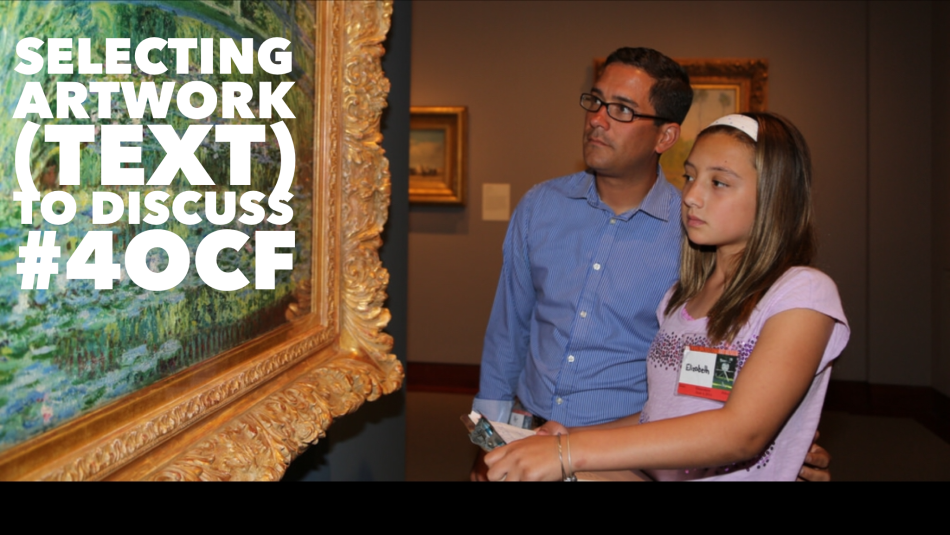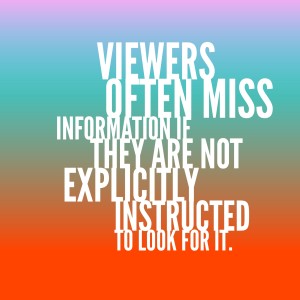When I select artworks to discuss with my students, I basically consider four things: interest, background knowledge, skills & concepts and opportunity. Although these four things usually work together, I often think of them separately so that I can scaffold thinking appropriately to try to meet the needs of all of my learners. By considering the needs of each student, and by taking the time to address their needs, I make room for each student to join the classroom discussion which helps them to feel like part of the group. This builds a sense of community and creates a positive classroom climate. I believe wholeheartedly, that when each student becomes part of the classroom community, their growth potential can be maximized.
Before I get into the four areas more explicitly, I want to point out the relationship that my artwork discussions have with English Language Arts. First, I think of these discussions as being similar to classroom read-alouds. Discussing artworks with students was something that I really struggled with. Using read-alouds as a sort of model helped me to realize the kinds of discussions about art that I had always dreamed of; ones where students could fully engage the work, discuss it meaningfully and connect it to their lives. Secondly, because we are using so much from the read-aloud model, my students, when viewing and discussing artworks, are not only viewing art really well and thoughtfully but are engaging in the forms of thinking that they need for academic success. Additionally, I also see books as a form of artwork, so although I am primarily discussing the selection of visual imagery, these four areas of consideration, as indicated in the title, could easily be applied to books, articles, poems or any other form of text.
Let’s look at the ideas of interest, background knowledge, skills & concepts, and opportunity a little more closely (no pun intended).
Interest:
Without a doubt, the easiest way to engage students is to put artworks (texts) in front of them that they are interested in. For instance, I love showing students who love sports, artworks, illustrations or photographs depicting sports. This is often helpful to engage many students in viewing and discussing art that don’t necessarily have a propensity to view art regularly. I also like to show artworks that are geared towards the age group that I’m working with. This makes it easier for students to relate. For instance, I often discuss picture book illustrations with elementary students. Another way to think about interest is to think about it in terms of selecting artworks that reflect what the students are studying in their classrooms. Both of these perspectives ensure that students will have enough background knowledge to support a discussion. This leads us to our next area of consideration: background knowledge or schema.
Background Knowledge:
It is paramount that students have enough background knowledge to support the conversation. If students do not have enough background knowledge readily available it is nearly impossible for them to discuss the artwork (text) fully. In the past, I have found that when I had selected an artwork that students do not have enough schema to discuss, it turns into a lecture very quickly-lectures rarely, if ever, equal engagement. Again, there are two ways to think about background knowledge, content and viewing. Content refers to the actual information in the artwork (text) and viewing refers to the students having enough viewing experience that they can actually pull out and make meaning of the information in the artwork. This once again, leads us to our next area of consideration: skills and concepts.
Skills & Concepts
Just as explicit instruction is required to teach reading, explicit instruction is required to teach viewing; it makes sense since they are both forms of text. So when I begin to discuss artwork with students, I try and have them use the skills right away that they will need to view other, perhaps more complex artworks. Much of this work has to do with helping students to pull information out of an artwork. For instance, I often have them verbally list everything they see. I think of this as decoding an artwork. It seems simple but surprisingly, even with relatively simple artworks, novice viewers often miss information if they are not explicitly instructed to look for it. Additionally, I explicitly instruct and model how to find patterns within artworks as well as text evidence. This type of work helps them to make-meaning from an artwork. When I do this type of work, I make sure that the artwork I put in front of the students is going to allow as many students as possible to be successful in engaging these skills and concepts. By starting with simple artworks which allow for a high level of success, I give more students an opportunity to join the conversation which helps them to build confidence. And this, once again, leads us to the next area of consideration: opportunity.
Opportunity
As with the other terms, there are different ways of thinking about opportunity. At first, I mainly want to give students the opportunity to engage the artwork and have the opportunity to join the conversation. Secondly, I want students to have an opportunity to use the skills & apply the concepts they need to be strong viewers. Thirdly, I want to give students the opportunity to expand their thinking. From this third perspective, I am looking to select artworks which push students to think more abstractly or to think differently. Even if every student can’t quite get to a higher level of thinking, hearing their peers’ complex thinking gives them an opportunity to hear it– unless they hear it, it is unlikely that they will figure it out on their own. Selecting images that do this also provides me an opportunity to grow as a viewer too. For when I give students the opportunity to make farther reaching connections, to use their diverse schema and set up situations where I don’t know all the answers, it gives us an opportunity to explore and discover together-that’s exciting!
Regardless of the kind of text you are selecting, I believe it is important to think about how this selection is going to impact your students. Is it going to enable them to do the work that you want (and need) them to do? I often tell my students, “Your first choice can set yourself up for success or it can set you up to struggle.” By thoughtfully selecting what we put in front of our students, we too can set them (and ourselves) up for success or set them (and ourselves) up to struggle.
Photo taken from http://classroomcloseup.org/segments/art-literacy-at-princeton/







These are 4 great categories that I agree with completely. Here are some other considerations that I add when I am considering art to share.
• Interest: I like to select art that is also appealing to me. If I am excited about a piece I think it comes through, and it certainly makes me linger longer and read closer. I think this is also akin Don Graves saying the writing teacher also needs to write in the writing workshop. We model through our own engagement.
• Skills and Concepts: For me this also includes age-appropriateness. I am still sorting this out for myself, but where I am now, I am not sure I would teach Hamlet’s “To be or not to be.” to young students even though readability formulas say they can handle it. The visual kin to that is Munch’s The Scream. It is fairly easy to understand but the angst is probably better with older students. (Yes, even though the Home Alone movie poster clearly plays off it.)
• Opportunity: This is where I am doing a lot of thinking. I think the visual arts can teach literary concepts to a broader range of learners in powerful ways. For example, when it comes to teaching metaphor, it might be especially effective for all students but especially visual learners or ESL students to begin with exploring the metaphors in Tanner’s The Banjo Lesson. Or use Copley’s Watson and the Shark to teach sequence of events. You can introduce the literary concept before you add on the added language/reading challenge. In this way the arts are not an incidental add on, but they are integral in launching instruction.
You can see more of my searchings on this matter here http://charlesmcquillen.com/category/ela-connect/